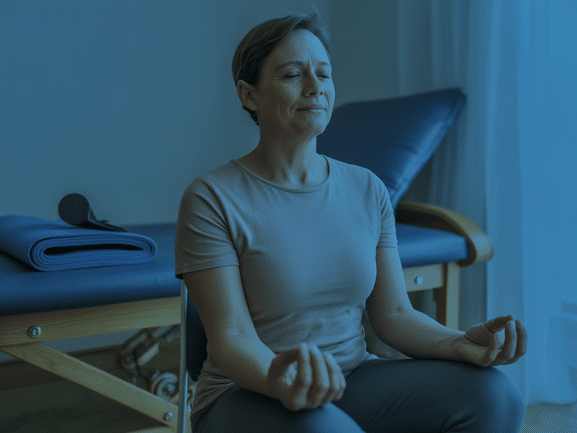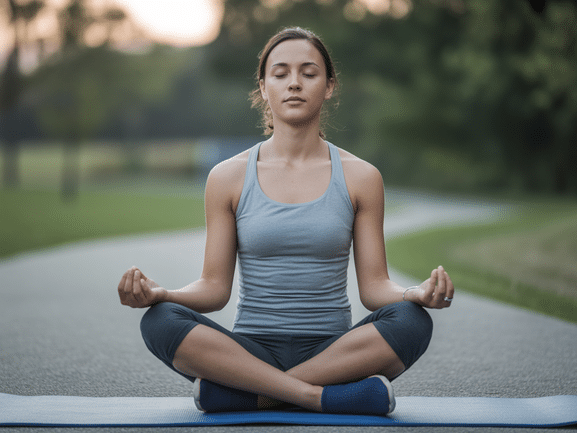Meditation for Physical Recovery: Accelerate Healing and Manage Pain
Meditation for physical recovery is the practice of using mindfulness to accelerate the body’s natural healing process after injury, surgery, or illness. This approach focuses the mind to reduce stress, manage pain, and create an internal environment that supports cellular repair and holistic well-being.
The road to recovery can be frustrating and painful. While physical therapy is crucial, you can empower your healing from within. By integrating meditation for physical recovery, you transform a vulnerable period into an opportunity for a profound mind-body connection. With platforms like Vitalizen App | Yoga + Meditation, these techniques are more accessible than ever.
The Science-Backed Connection: How Meditation Boosts Healing
Your mental state directly influences your physical health. During rehabilitation, stress and anxiety can elevate cortisol levels, leading to increased inflammation and slower healing. Meditation actively counteracts this by calming the nervous system and promoting restorative processes.
According to research from institutions like Johns Hopkins University, mindfulness meditation effectively reduces pain perception. A 2025 study confirmed that patients practicing meditation reported a 30% decrease in pain-related distress. Furthermore, studies from sources like the Harvard Gazette show that meditation can positively impact the immune system, a cornerstone of effective healing.
The primary benefits of healing meditation for your recovery journey include:
- Effective Pain Management: Mindful techniques alter your relationship with pain, reducing its perceived intensity and your emotional reaction to it. This is a key aspect of meditation for physical recovery.
- Reduced Stress and Inflammation: Meditation lowers cortisol, which helps decrease systemic inflammation. This creates an optimal environment for your body to heal efficiently.
- Improved Sleep Quality: Quality sleep is vital for tissue repair. Discomfort often disrupts rest, but meditation calms the mind, making it easier to fall and stay asleep.
- Enhanced Body Awareness: Mindfulness teaches you to listen to your body’s signals. This helps you distinguish between healing sensations and pain that signals overexertion, ensuring a safer recovery.
- Strengthened Immune Response: By reducing stress, meditation allows your immune system to function more effectively, dedicating more resources to repairing damaged tissues.
What Are the Best Meditation Techniques for Healing? A Step-by-Step Guide
These healing meditation techniques are adaptable. You can practice them in a chair, lying in bed, or any position that feels supportive. You don’t need to be an expert to begin your meditation for physical recovery journey.
-
Mindful Breathing: The Foundation
This is the starting point for all mindfulness. Simply bring your full attention to your breath. Notice the sensation of air entering your body, the rise and fall of your chest, and the release on the exhale. When your mind wanders, gently guide it back. Start with just 3-5 minutes.
-
Body Scan Meditation: For Deep Release
Lie down comfortably and close your eyes. Bring your attention to your toes. Notice any sensations—warmth, tingling, pressure—without judgment. Slowly move your awareness up your body: feet, legs, torso, arms, neck, and head. This is excellent for releasing hidden tension and improving body awareness.
-
Visualization for Healing: Directing Your Intention
Close your eyes and create a mental image of your injury. Now, visualize a warm, healing light surrounding this area. Imagine this light soothing the tissues, reducing inflammation, and knitting everything back together, strong and whole. This technique uses focused intention to support the healing process.
-
Loving-Kindness Meditation: For Emotional Resilience
Recovery can be emotionally taxing. Cultivate self-compassion by silently repeating phrases like: “May I be safe. May I be healthy. May I heal with ease.” This shifts your mindset from frustration to self-care, which is vital for long-term recovery.
-
Guided Meditation for Pain Relief: Expert Support
Sometimes, the easiest way to start is by letting an expert guide you. The Vitalizen app offers a library of guided sessions for pain management, making it one of the best meditation apps for physical therapy support.
💡 Tip: Ready to try one of these techniques? The Vitalizen app offers guided versions of all these meditations. Download it for free and start your first session today!
Integrating Meditation into Your Daily Recovery Routine
Consistency is more important than duration. A successful meditation for physical recovery practice is one that fits seamlessly into your life. Here’s how to start.
- Schedule It: Dedicate a specific time each day, just as you would for physical therapy. Attaching it to an existing habit, like waking up or before bed, can help.
- Start Small: Commit to just 5 minutes a day. Use a timer or a short guided meditation. As you feel more comfortable, you can gradually increase the duration.
- Create a Comfortable Space: Your only goal is to be supported. This might be lying in bed with pillows or sitting in a chair. Do not endure pain to hold a specific posture.
- Be Patient and Kind: Your mind will wander. That’s normal. The practice is not about having an empty mind; it’s about gently returning your focus each time you get distracted. There is no failure.
Common Hurdles in Healing Meditation and How to Overcome Them
- “I can’t focus, my mind is too busy.” This is the most common challenge. The goal isn’t to stop thoughts, but to notice them without judgment and return to your anchor (your breath). Each time you return your focus, you are strengthening your mindfulness muscle.
- “I keep falling asleep.” If you’re recovering, your body needs rest! Falling asleep is okay. If you want to stay awake, try practicing in a seated position or at a time of day when you feel more alert.
- “It feels like it’s not working.” The effects of meditation are cumulative. You may not feel a dramatic shift in one session, but over time, you will notice changes in your stress levels, pain perception, and emotional state. Trust the process.
Comparison of Healing Meditation Techniques
| Technique | Primary Benefit | Best Position | Recommended Time |
|---|---|---|---|
| Mindful Breathing | Stress reduction, focus | Any (sitting or lying) | 3-10 minutes |
| Body Scan | Releasing tension, body awareness | Lying down | 10-25 minutes |
| Visualization | Targeted healing, positive mindset | Lying or sitting | 5-15 minutes |
| Loving-Kindness | Emotional resilience, self-compassion | Sitting | 5-10 minutes |
Your Healing Journey, Supported by Vitalizen
We understand that every recovery journey is unique. That’s why Vitalizen was designed to be your adaptable wellness partner, making it easier to practice meditation for physical recovery.
- Accessible Practices: A wide range of seated and supine meditations that require no special equipment or flexibility.
- Specialized Programs: Curated collections of sessions focused on “Pain Management,” “Stress Reduction,” and “Healing.”
- Adjustable Durations: Start with just 5 minutes a day and gradually increase as you feel more comfortable.
🎯 Ready to start? Don’t let physical limitations stop you from accessing profound mental and emotional support. Start your wellness journey now and discover how our app can be a vital part of your recovery toolkit.
Frequently Asked Questions (FAQ)
How can I meditate while recovering from an injury if I can’t sit still?
You don’t have to sit still. The most important rule is to be comfortable. You can practice meditation lying down in bed, reclining in a chair, or even during a gentle, approved stretch. The Body Scan technique, for example, is specifically designed to be done while lying down to maximize comfort and release physical tension.
How long should I meditate for pain relief?
Start small. Even 3-5 minutes of focused practice per day can make a significant difference in your pain perception and stress levels. Consistency is much more important than duration. As you become more comfortable, you might naturally extend your sessions to 10-15 minutes. Listen to your body and use an app like Vitalizen to find the perfect length for you.
Is there a right or wrong way to do this?
There is no wrong way to meditate for recovery. The goal is not to force an empty mind, but to gently guide your attention back to a focal point (like your breath or a sensation) whenever it wanders. Be kind and patient with yourself; the simple act of showing up and trying is the practice itself. Every session is beneficial, regardless of how distracted you feel.
Ready to explore more? Check out our other articles and tips on yoga and meditation. If you have any questions, feel free to contact us.


